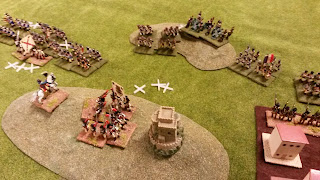John continued his tour of unknown Peninsular War battles with this offering of Almonacid, which evidently took place in 1809 between a French Corps under Sebastiani and a Spanish Corps under General Venegas. As usual, we played this with Johns 15mm troops using Brown Bess. Each unit is roughly a regiment or brigade (grouped into divisions - so a division has 2-4 units).
The French have just crossed the Tagus and Venegas decided to try and stop them.
View from the Spanish right flank. We had to defend the hills for a number of turns and then withdraw intact. Tim G took the Spanish left and I had the Spanish right.
The wicked French in their sinister black uniforms. Robert, Andrew and Tim C.
The Spanish centre was held in depth, with Venegas himself on Castle Hill. In the face of the French artillery, a reverse slope position seemed prudent.
Over on the left, we massed all the Spanish artillery, supported by a cavalry division and a weak infantry division.
The Spanish right was held by an infantry and a cavalry division, also deployed on the reverse slopes.
As the French advanced, the Spanish cavalry moved forwards to do battle. These 'French' turned out to be Germans.
Over on the left, more 'French' decided a frontal attack on gun hill would be a good idea. These chaps were actually Polish.
The cavalry melee on the right went as well as expected, with the French dishing out death and destruction.
The Poles seemed a bit unsure what to do and formed square right in front of 'gun hill' while one lone regiment pushed forwards.
The Spanish cavalry engaged the French, supported by a square.
Meanwhile the Spanish cavalry on the right were routed, so the infantry formed square, which seemed to put the French cavalry off.
The French infantry crashed into the Spanish centre, which didn't go too well for us.
But over on gun hill, the massed artillery did terrible execution with canister and completely destroyed one French regiment.
Soon to be followed by two more. Ouch!
Another attack came on in the same old way, and was met with unusually withering fire from the Spanish infantry.
Sadly things weren't going as well in the centre. Venegas was starting ot look a bit lonely.
Oops.
Venegas led the heroic countercharge.
Only to come unstuck and die in the ensuing massacre.
The French began to assault gun hill, losing a cavalry brigade and a fourth infantry regiment in the process.
The French meanwhile pressed on into Almonacid itself.
With predictable results. So much for the defensive benefits of buildings.
The square on gun hill was still holding out.
But the square on Castle Hill was blown to bits by close ranged French artillery. Tim C showed great skill in combined arms operations.
The Spanish counterttacked into Almonacid.
But the French were about to overrun Castle Hill.
Thew writing was on the wall for gun hill too as the squares began to collapse.
Finally, turn ten was reached the right hand Spanish division made good its escape.
Sadly the last survivors of the division holding Castle Hill were pinned in square and not long for this world.
As were the remnants on Gun Hill.
Oh well, no-one expects the Spanish to do well and in the historical battle the Spanish were largely routed, apart from their right wing which withdrew. Amazingly, we managed to replicate this result more by luck than judgement, although irl Venegas was sacked after the battle rather than dying heroically during it.
The real Spanish victory in this battle were the monumental losses we inflicted on the French, four entire infantry regiments destroyed and a cavalry regiment too. Frontal assaults on massed artillery are a really bad idea, but sadly for us, despite this tactical blunder, the French numbers and quality were just too much for us.



























































